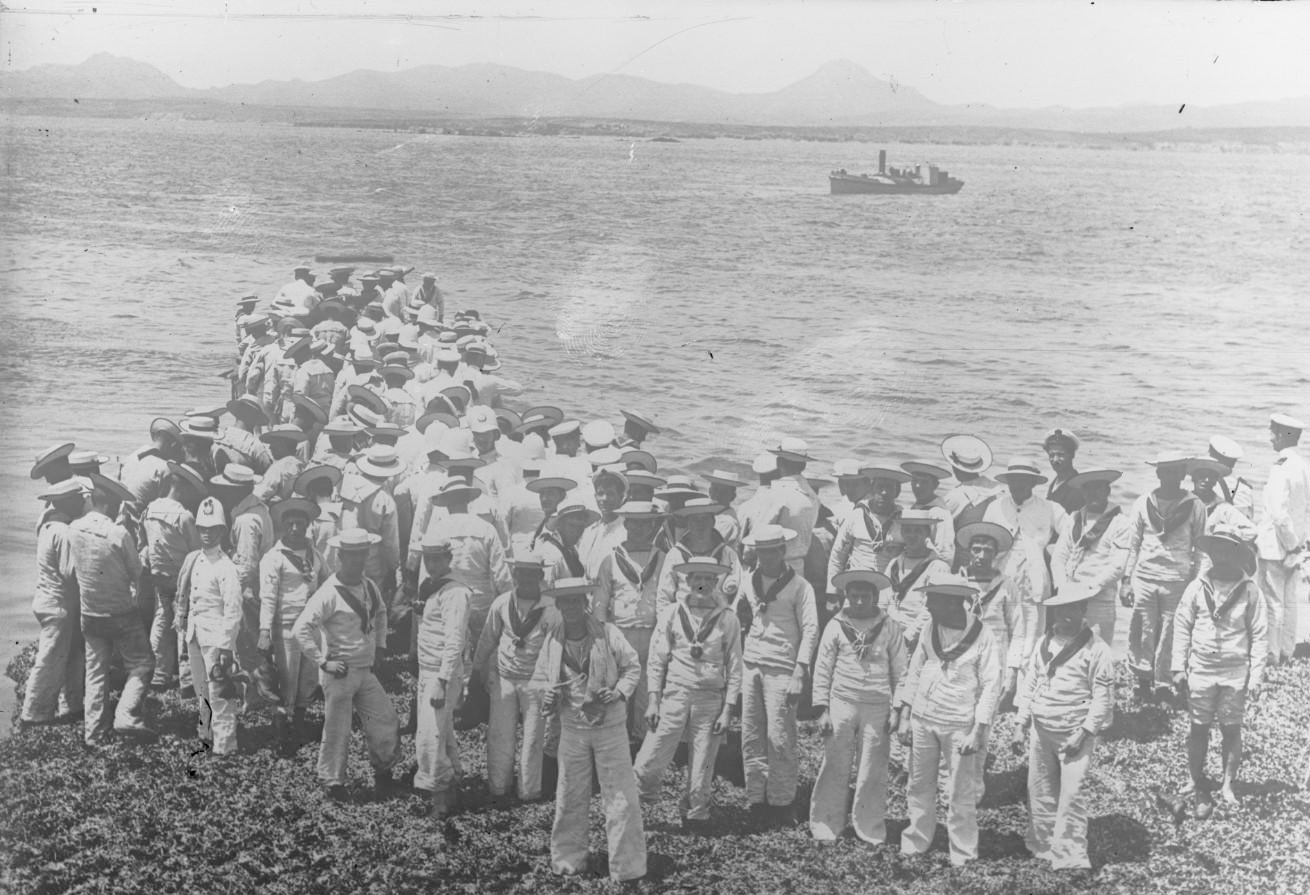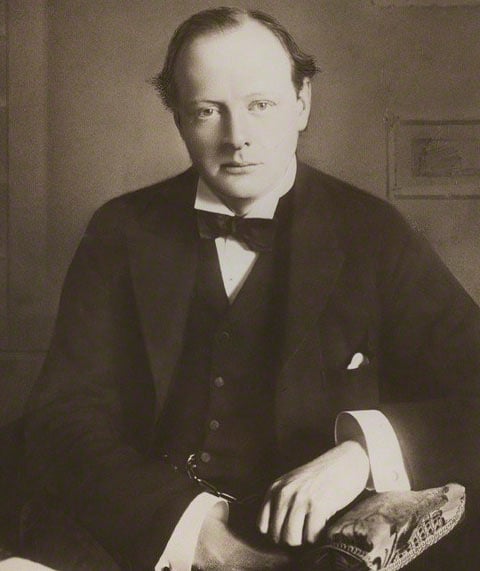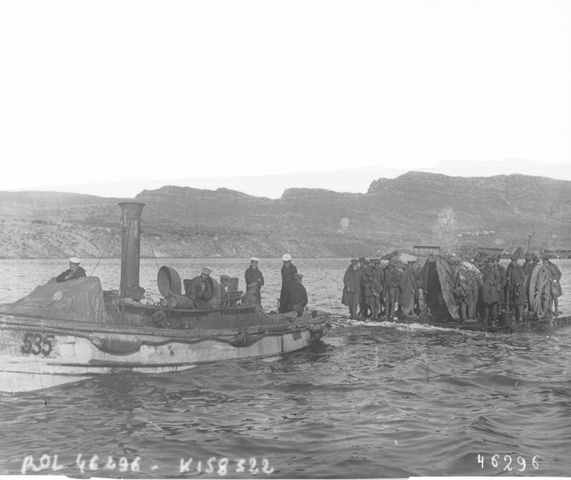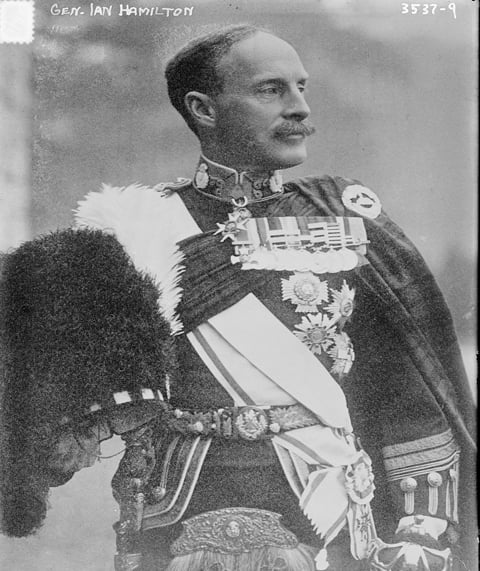


In late 1914 it was clear to the allies that there would be no quick victory in World War One. The western front had become static, and a costly trench war had begun. In November 1914, Winston Churchill, then First Lord of the Admiralty, suggested that if a new front was opened up against Turkey (which he considered the weakest of the enemy powers), the Germans would have no choice but to move troops east to assist the Turks. This in turn would weaken the German forces on the western front and eventually lead to an allied victory.
Churchill was in favour of a rapid naval engagement with the Turks. He believed that this would not only give the allies naval control of the Dardanelles, but that a naval bombardment would destroy Turkish land defences thereby allowing an allied army to move forward to Constantinople. This would then allow, at little cost to the allies, the eastern front against the Germans and her allies to be opened. Churchill also believed that a decisive strike against Turkey would bring Bulgaria and Romania into the war on the allied side.
The original plan for the Dardanelles campaign was that it would be a purely naval campaign. The plan was for a force of British battleships, submarines and minesweepers to take control of the Dardanelles. Once the way had been cleared a small armed force would then secure Constantinople. On 19 February 1915 two British destroyers were ordered to begin attacks on Turkish strongholds in the area. The campaign continued through late February and early March, and while damage was done to the forts at Sedd el Bahr and Kum Kale, the attacks were not decisive. The naval operation was also hampered by the large numbers of mines the Turks had placed in the waters and the difficulty, due to a lack of minesweepers and the shifting currents in the straits, in successfully clearing them.
On 18 March the British navy mounted a major attack against the Turkish defensive positions. The aim was to remove the Turkish strongholds where their artillery was stationed and, once this had been achieved, to allow the minesweepers to work unhindered and clear the waters. The attack was a disaster. While some damage was done to the Turkish inland strongholds, four ships struck a major placement of Turkish mines and were either badly damaged or else sunk. In all, nearly 700 naval personnel lost their lives that day.
After the failure of the 18 March offensive, and criticism that the fleet that had been assembled consisted of older ships that weren't fit for purpose, the naval campaign was called off. The British decided that while the naval campaign had failed, the objective - taking Turkey out of the war - was still alive. Lord Kitchener decided that ground forces would be used to take out the Turkish inland strongholds and artillery. Once that had been done, then minesweepers could be safely employed and the Dardanelles taken.


General Sir Ian Hamilton was placed in charge of the land campaign. His forces, expected to be between 70,000 and 80,000 strong would be made up of Australian and New Zealand troops (ANZACs) as well as British and French troops. With the ANZACs in basic training in Egypt, and the British and French troops elsewhere in Europe, it took time for Hamilton to gather his army in the region. The attack was planned originally for 23 April, but the time lag between the end of the naval campaign and the start of the land assault gave the Turks time to strengthen their defensive positions.
The Turks were under the command of a German officer, Otto Liman von Sanders. An awareness of where the allies were most likely to land on the peninsula and the best positions for defence were largely dictated by a young Turkish officer Mustafa Kemal, who was familiar with the area having fought there during the earlier Balkan War. The Turks had some 60,000 troops ready on the Gallipoli peninsula awaiting the allied arrival.
The initial landings schedule for 23 April were delayed for 48 hours due to bad weather. The allied assault on Gallipoli began on the morning of 25 April 1915. The allied troops landed on six beaches on the Gallipoli peninsula. The northern beaches were the focus of the Australian and New Zealand troops and that zone became known as ANZAC, while the southern beaches, the focus of British and French forces, became the Helles zone. The landings were made by troops packed into rowing boats or else, as at V Beach, from a grounded ship, from which the troops were to run ashore via ramps. While two of the landings were made with little Turkish opposition, the landings at V and W beaches and at ANZAC, were met by intense Turkish fire. At V and W beaches the allied troops suffered casualty rates of 60-70% on the first day. At ANZAC, while the beach was secured, the heavy fighting cost the lives of every member of the Turkish 57th Regiment.
While all the beaches were secured by the end of the first day, the allies made little progress inland. With the Turkish positions on high ground above the beaches their positions largely remained secure. The next few months saw various allied and Turkish attempts to gain the upper hand, but effectively the campaign stalled and rapidly began to resemble the static trench warfare of the western front.
The allies made a major attempt to gain the upper hand on 6 August when an assault was made on the Turks via a landing at Suvla Bay. The landing was successful, and fighting continued throughout August in an allied attempt to progress inland. Despite a massive buildup of troops, and an appalling loss of life, the August offensive failed. During the summer months the hot conditions, and a constant struggle by the allies to supply enough fresh drinking water to its troops, meant that conditions at Gallipoli were awful. Large numbers of troops, on both sides, succumbed to a dysentery epidemic that spread across the peninsula in the late summer.

With stalemate in Gallipoli by the autumn of 1915 and little apparent sign of any potential victory, allied commanders began to explore the possibility of an evacuation of forces. In early November General Kitchener visited Gallipoli and discussed the situation with commanders stationed on the peninsula. The decision to evacuate was made, and Kitchener passed this on to the War Cabinet in London. In planning the evacuation, allied commanders had anticipated a Turkish assault and an associated heavy loss of life. In the event, the evacuation was the single most successful part of the Gallipoli campaign. Between early December and 8 January 1916, nearly 40,000 troops and tons of equipment were successfully taken off the peninsula.
The Gallipoli campaign lasted just over eight months. As a military operation it was a complete failure with the allies failing in their objectives of opening up the Dardanelles and taking Turkey out of the war. For the Turks Gallipoli was a great victory, and their hero of the campaign, Mustafa Ataturk would become the nation’s President in 1923.

The cost of Gallipoli was enormous in terms of human life, with an estimated 130,000 men losing their life in action or from diseases contracted while on the peninsula. In that total are approximately 4,000 Irish men who never returned home. Most historians argue that while the Gallipoli campaign was a closely fought contest, it had no bearing on the final outcome of the war. The failure of the campaign ended the military career of General Sir Ian Hamilton and led to the demotion of Winston Churchill from First Lord of the Admiralty. The British Prime Minister, Herbert Asquith, was held partially responsible for the failure at Gallipoli and was forced from office in December 1916.
For the Australians the sacrifices of the ANZACs became a central part of the national narrative, and the focus for remembering the nation’s war dead on the 25 April each year. In Ireland the Gallipoli sacrifice was largely forgotten in the wake of the political changes on the island brought about by the 1916 Rising and the ensuing revolutionary period. In Gallipoli the legacy of the campaign is clear. The landscape still bears the marks of trenches and artillery bombardments, while there are 44 separate war cemeteries. The cemeteries honour the dead of all those nations that fought at Gallipoli, but due to the nature of the fighting and the complexity of recovering bodies during the campaign, the vast majority of soldiers who died have no known grave. The Irish dead are remembered at various sites across Gallipoli, with the cemetery at V beach listing the names of the bulk of Irishmen who died.